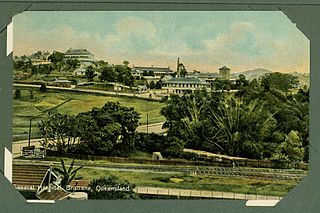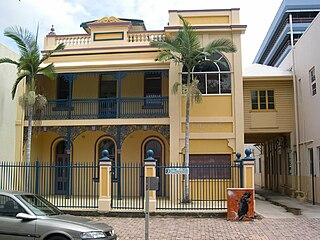
Spring Hill is an inner northern suburb in the City of Brisbane, Queensland, Australia. In the 2016 census, Spring Hill had a population of 5,974 people.

McWhirters is a heritage-listed former department store at Wickham Street, Fortitude Valley, City of Brisbane, Queensland, Australia. It is also known as McWhirters Marketplace, McWhirters & Son Ltd, and Myer. It was added to the Queensland Heritage Register on 21 October 1992.

Siegfred Karl Kast was a German immigrant to Australia who shot dead two doctors and unsuccessfully attempted to detonate a bomb in Wickham Terrace, Brisbane, before committing suicide.

Lady Bowen Hospital is a heritage-listed former maternity hospital at 497-535 Wickham Terrace, Spring Hill, City of Brisbane, Queensland, Australia. It was designed by John H. Buckeridge and built from 1889 to 1890 by John Quinn. It was also known as Brisbane Lying-In Hospital, Lady Bowen Hostel, and Anzac House & Club. It was added to the Queensland Heritage Register on 23 April 1999.

Baptist City Tabernacle is a heritage-listed church at 163 Wickham Terrace, Spring Hill, Brisbane, Queensland, Australia. It was designed by Richard Gailey and built from c. 1889 to 1890. It was added to the Queensland Heritage Register on 21 October 1992.

Wickham Hotel is a heritage-listed hotel at 308 Wickham Street, Fortitude Valley, City of Brisbane, Queensland, Australia. Originally trading as the Oriental, it was designed by Richard Gailey and built in 1885 by Cussack & O'Keefe. It was added to the Queensland Heritage Register on 21 October 1992.

Winchcombe Carson Woolstores is a heritage-listed warehouse at 54 Vernon Terrace, Teneriffe, City of Brisbane, Queensland, Australia. It was designed by architect Claude William Chambers and built in 1910-11 by Stuart Brothers of Sydney who extended it in 1934. The woolstore was added to the Queensland Heritage Register on 21 October 1992.

Craigston is a heritage-listed apartment block at 217 Wickham Terrace, Spring Hill, City of Brisbane, Queensland, Australia. It was designed by Atkinson & Conrad and built in 1927. It was added to the Queensland Heritage Register on 21 October 1992.

AMA House is a heritage-listed villa at 188 L'Estrange Terrace, Kelvin Grove, City of Brisbane, Queensland, Australia. It was built from c. 1914 to c. 1916. It is also known as BMA House and Hunstanton. It was added to the Queensland Heritage Register on 4 July 1995.

Wickham Terrace is one of the historic streets of Brisbane, Queensland, Australia. It is known as the street of private medical specialists.

Brisbane General Hospital Precinct is a heritage-listed hospital precinct at 40 Bowen Bridge Road, Herston, City of Brisbane, Queensland, Australia. It was built from 1875 to 1941. It includes six historic buildings associated with the Royal Brisbane and Women's Hospital and the former Royal Children's Hospital, as well as aspects of their grounds and landscaping. It was added to the Queensland Heritage Register on 28 March 2003. A number of buildings in the precinct, in particular the Lady Lamington Nurses Home, will be redeveloped as part of the Herston Quarter development.

United Service Club Premises is a heritage-listed club house at 183 Wickham Terrace, Spring Hill, City of Brisbane, Queensland, Australia. It was designed by architect Claude William Chambers and built from 1906 to 1947. It is also known as Montpelier and The Green House. It was added to the Queensland Heritage Register on 28 April 2000.

Inchcolm is a heritage-listed former office building at 73 Wickham Terrace, Spring Hill, City of Brisbane, Queensland, Australia. It was designed by Eric P Trewern and built in 1930 by J I Green & Son. It was converted into a hotel in 1998, and renovated in 2014. It now trades as Ovolo Inchcolm under the Ovolo Hotels Group. It was added to the Queensland Heritage Register on 23 March 1998.

Lister House is a heritage-listed office building at 79 Wickham Terrace, Spring Hill, City of Brisbane, Queensland, Australia. It is also known as the Brisbane Clinic. It was designed by Raymond C Nowland and built from 1930 to 1948 by J I Green & Son. It was added to the Queensland Heritage Register on 21 October 1992.

Ballow Chambers is a heritage-listed office building at 121 Wickham Terrace, Spring Hill, City of Brisbane, Queensland, Australia. It was designed by Lange Leopold Powell and built from 1924 to 1926 by John Hutchinson. It was added to the Queensland Heritage Register on 21 October 1992.

Athol Place is a heritage-listed terrace house at 307 Wickham Terrace, Spring Hill, City of Brisbane, Queensland, Australia. It was built in the 1860s by Alexander McNab. It was added to the Queensland Heritage Register on 21 October 1992.

St Andrews War Memorial Hospital Administration Building is a heritage-listed former house and residential college and now hospital administration building at 465 Wickham Terrace, Spring Hill, City of Brisbane, Queensland, Australia. It was built from 1860s to 1936. It was also known as Emmanuel College. It was added to the Queensland Heritage Register on 24 March 2000.

BAFS Building is a heritage-listed former pharmacy at 331 & 333 George Street, Brisbane City, City of Brisbane, Queensland, Australia. It was designed by Lange Leopold Powell and built from 1915 to 1916 by B Cunningham. It was added to the Queensland Heritage Register on 22 February 2002.

Harris Terrace is a heritage-listed terrace house at 68 George Street, Brisbane City, City of Brisbane, Queensland, Australia. It was designed by J & G Cowlishaw and built from c. 1866 to c. 1867 by Mr Clarke. It is also known as Harris Court. It was added to the Queensland Heritage Register on 21 October 1992.

Osler House is a heritage-listed detached house at 35 Sturt Street, Townsville CBD, City of Townsville, Queensland, Australia. It was designed by W G Smith & Sons and built from 1888 to 1950s. It was added to the Queensland Heritage Register on 21 October 1992.






















